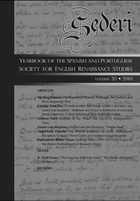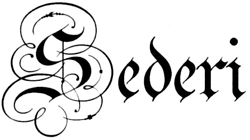
Sederi 20
Sederi 20 — 2010
EDITORS
Berta Cano Echevarría & Ana Sáez-Hidalgo
REVIEW EDITOR
Francisco José Borge López
ISSN 1135-7789
R. Scott Fraser, ““The king has killed his heart”: The Death of Falstaff in Henry V.” SEDERI 20 (2010): 145-157.
DOI: https://doi.org/10.34136/sederi.2010.7 Download PDF
Abstract
Even with the multitude of religious, political, social and gendered readings of the character, critics have invariably (and understandably) tended to focus most often on the events leading up to and including the rejection scene in 2 Henry IV, and have given far less attention to the report of his death in Henry V. In light of criticism concerning the relationship between Falstaff and the actor Will Kemp, as well as the roles of the stage Vice and clown, this essay will focus on the report in an attempt to reinterpret it and its importance for the play as a whole. As will be seen, in performance it actually formed an integral part of an iterative process that would have served to problematize the presentation of kingship in Henry V on the early modern stage.
Keywords: Shakespeare; Falstaff; Henry V; Will Kemp.
References
Cox, John D. 2000. The Devil and the Sacred in English Drama, 1350-1642. Cambridge: Cambridge University Press.
Hall, Jonathan 1998. “The Evacuations of Falstaff (The Merry Wives of Windsor).” Ed. Ronald Knowles. Shakespeare and Carnival: After Bakhtin. London: Macmillan: 123-151.
Hazlitt, William 1889. William Hazlitt Essayist and Critic. London: Frederick Warne and Co.
Hodgdon, Barbara 1991. The End Crowns All: Closure and Contradiction in Shakespeare’s History. Princeton: Princeton University Press.
Howard, Jean E. 1997. “1 Henry IV.” Ed. Stephen Greenblatt. The Norton Shakespeare. London: W. W. Norton and Company: 1147-1156.
Laroque, François 1998. “Shakespeare’s ‘Battle of Carnival and Lent’. The Falstaff Scenes Reconsidered (1 & 2 Henry IV).” Ed. Ronald Knowles. Shakespeare and Carnival: After Bakhtin. London: Macmillan: 83-96.
Lewis, Charlton T. and Charles Short eds. 1879. A Latin Dictionary. Oxford: At the Clarendon Press.
Nicholson, Brinsley 1882. “Kemp and the Play of Hamlet – Yorick and Tarlton – A Short Chapter in Dramatic History.” The New Shakespeare Society’s Transactions (1880-1882). Part 1. London: Trübner and Ludgate Hill: 57-66.
Poole, Kirsten 1998. “Facing Puritanism: Falstaff, Martin Marprelate and the Grotesque Puritan.” Ed. Ronald Knowles. Shakespeare and Carnival: After Bakhtin. London: Macmillan: 97-122.
Rackin, Phyllis 1991. Stages of History: Shakespeare’s English Chronicles. London: Routledge.
Rossiter, A. P. 2004 (1964). “Ambivalence: The Dialectic of The Histories.” Ed. Russ McDonald. Shakespeare: An Anthology of Criticism and Theory. Oxford: Blackwell: 100-115.
Ruiter, David 2003. Shakespeare’s Festive History: Feasting, Festivity, Fasting and Lent in the Second Henriad. Aldershot: Ashgate.
Shakespeare, William 1997. The Norton Shakespeare. Ed. Stephen Greenblatt. London: W. W. Norton and Company.
Shakespeare, William 1982 (1599). Henry V. Ed. Gary Taylor. The Oxford Shakespeare. Oxford: Clarendon Press.
Shakespeare, William 1995 (1599). King Henry V. Ed. T. W. Craik. The Arden Shakespeare, Third Series. London: Thomson Learning.
Spivack, Bernard 1984 (1958). “The Vice as a Stage Metaphor.” Ed. Peter Happé. Medieval English Drama: A Casebook. Basingstoke: Macmillan: 140-144.
Weimann, Robert 2000. Author’s Pen and Actor’s Voice: Playing and Writing in Shakespeare’s Theatre. Cambridge: Cambridge University Press.
Wiles, David 1987. Shakespeare’s Clown. Cambridge: Cambridge University Press.
Wilson, John Dover 1943. The Fortunes of Falstaff. Cambridge: Cambridge University Press.
